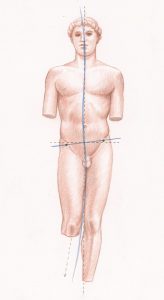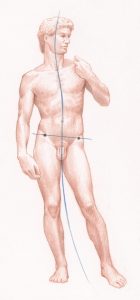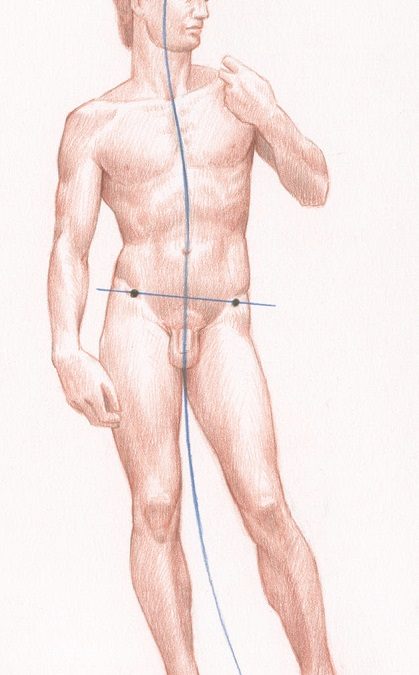ROBERTO OSTI
Understanding Contrapposto
Contrapposto describes a category of pose that artists have favored for thousands of years.
Even though “contrapposto” is an Italian word, the earliest sculptures that depict the human body posed in this specific stance date back to the 5th century B.C. in classical Greece.
The typical contrapposto pose shows the counterposing of various segments of the figure: The pelvis and rib cage are tilted in opposite directions, and one leg is straight while the other is bent.
This deliberate counterposing can contribute various expressive qualities to a figure.
It can aid the artist in achieving a sense of movement and elegance, and it can also help to reveal the psychology and emotional life of a subject.
NOT CONTRAPPOSTO
To better understand contrapposto, we can start by looking at an example that is not contrapposto.
Consider the illustration 1, a drawing of an ancient Greek Kouros sculpture that portrays a figure in a very symmetrical and rigid pose:
Consider the illustration 1, a drawing of an ancient Greek Kouros sculpture that portrays a figure in a very symmetrical and rigid pose:

- The weight of the body is equally distributed between the two legs.
- The arms are straight and parallel along the sides of the body.
- The body can be divided in two symmetrical halves by a vertical line, referred to as the “line of the center of gravity.”
- The pelvis is not tilted, as we can see from the horizontal line.
CHARACTERISTICS OF CONTRAPPOSTO
A contrapposto pose can be seen in illustration 2, showing a later sculpture that represents the beginning of the Greek classical style.
The sense of life is expressed by the much more correct and realistic anatomy and by the relaxed, lifelike pose:
The sense of life is expressed by the much more correct and realistic anatomy and by the relaxed, lifelike pose:

- The head, chest and pelvis are aligned along a slightly S-curved line running from the top of the head to the ground.
- The pelvis is tilted.
- One leg is engaged—it is straight and carries most of the weight of the body.
- The other leg is free—slightly bent and relaxed, carrying little weight.
CONTRAPPOSTO IN THE RENAISSANCE
During the Renaissance, the classical ideals of the Greeks were revived, and artists showed a renewed interest in the realistic depiction of the figure.
In illustration 3, we see how Michelangelo’s David demonstrates a methodical application of contrapposto:
In illustration 3, we see how Michelangelo’s David demonstrates a methodical application of contrapposto:

- David’s head, torso, pelvis and legs are all aligned along an elegant S-curve.
- The pelvis is tilted.
- This elegant pose, along with the accurate anatomy, contributes to the sculpture’s powerful sense of life and psychological intensity.
BREAKING IT DOWN
To better appreciate how the forms of a contrapposto figure are organized, we can reduce the organic forms of the body to basic volumes.
Illustration 4 shows the basic volumes of David:

- The head is slightly tilted to the right and turned to a three-quarters view.
- The rib cage is tilted to the left.
- The pelvis is tilted to the right.
- One leg is straight and engaged; the other is free and slightly flexed.
CONTRAPPOSTO IN MULTIFIGURE COMPOSITIONS
Contrapposto is not limited to single figures. It can also be used in paintings such as the complex arrangement found in Raphael’s The Three
Graces (see illustration 5):


- The head, torso and legs of all three figures are oriented at different angles, creating S-curves running down the length of each figure.
- The pelvic tilt is evident in all three figures.
- The feet alternate between engaged and free.
- The poses themselves alternate. The first S-curve is oriented opposite to the second. The second and third S-curves have the same orientation, but the poses are opposite in a different sense, as the figures are facing each other.





1 Comment
[…] And you’ll find additional information on what is and what isn’t contrapposto here: Understanding Contrapposto. […]